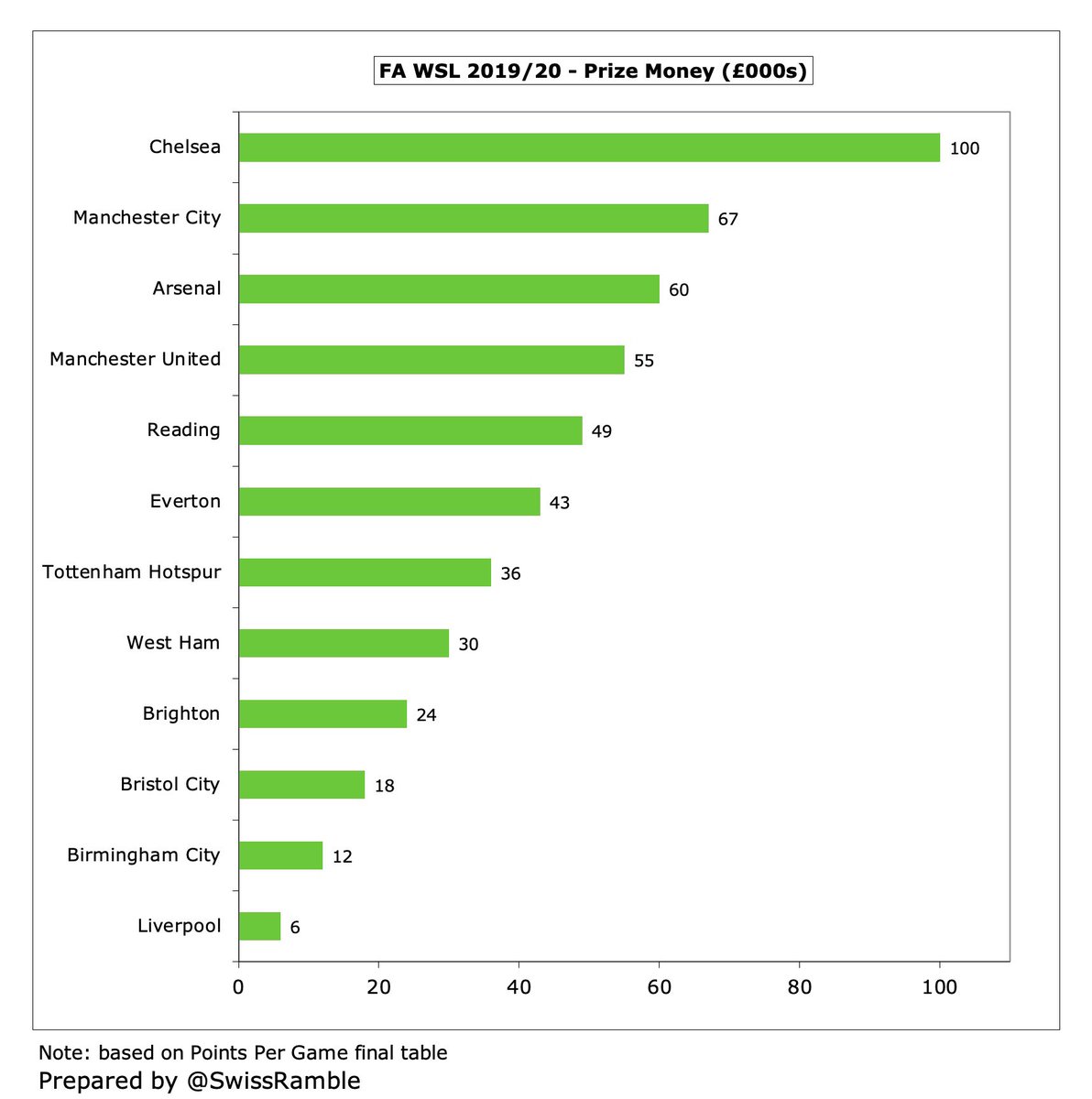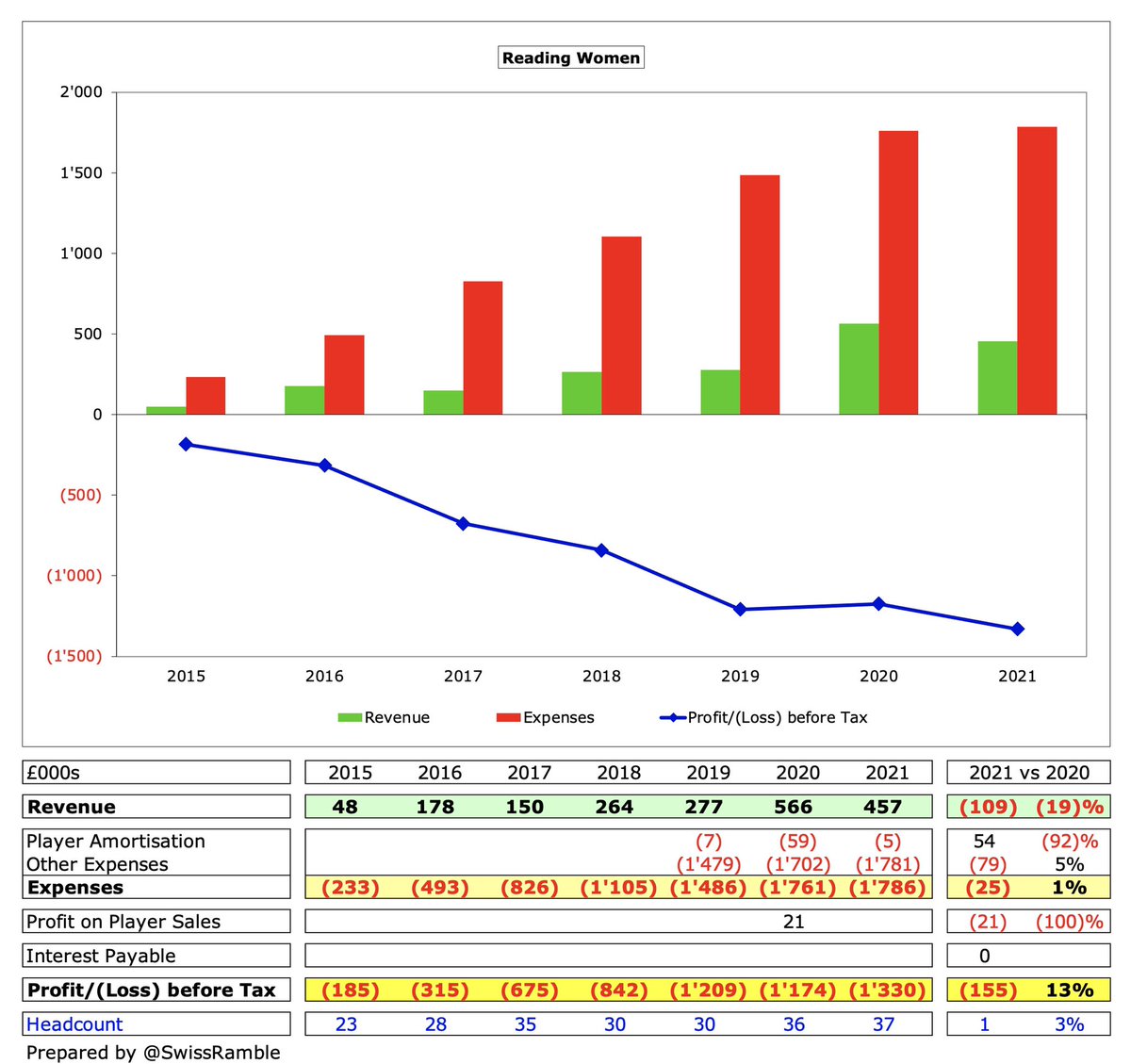In advance of the Women’s Euro 2022, I thought it might be interesting to review the finances of the FA Women’s Super League (WSL) for the 2020/21 season, albeit severely impacted by the COVID-19 pandemic with almost all games played behind closed doors.
Reviewing WSL financials is made more difficult by the fact that not all clubs publish detailed accounts, so some lack information on revenue, expenses, wages and headcount. Nevertheless, there is enough data available to identify some common themes.
Overall the WSL reported a record pre-tax loss of £9.7m for 2020/21, which was £2.5m more than the previous season’s £7.2m and slightly higher than the £8.9m deficit in 2018/19. Note: the WSL increased the number of clubs from 11 in 2019 to 12 in 2020. 

WSL clubs invariably operate at a loss with their parent companies covering the shortfall. Only 3 clubs reported profits (#MUFC £173k, #EFC £168k & #AFC £24k), with 9 of the 12 losing money – 5 above a million: #BHAFC £2.2m, #MCFC £1.7m, #THFC £1.7m, #CFC £1.6m & Reading £1.3m. 

Largest profit improvement was at #AVFC £589k, following promotion from the Women’s Championship, then #CFC £195k and #EFC £168k. However, there were significant increases in losses at #MCFC £1.4m, #THFC £457k and #WHUFC £396k. 

Despite the adverse impact of the pandemic, WSL total revenue rose 4% from £17.9m to £18.7m in 2020/21. This means that revenue has more than doubled in just three years from the £8.5m reported in 2017/18. 

#CFC enjoyed by far the highest revenue with £5.3m, followed by #AFC £4.3m #EFC £2.9m, #MCFC £2.9m and #MUFC £1.3m. It is worth noting that WSL revenue by club largely depends on how much income is shared from the parent company (usually as commercial). 

Three clubs experienced large year-on-year revenue growth: #CFC £1.5m, #EFC £1.2m and #AFC £491k. On the other hand, there were large falls at #MUFC £479k, Birmingham City £334k and Reading £109k. 

In addition to the reported revenue, three WSL clubs benefited from “other operating income”, especially #MUFC £1.8m, though the accounts did not provide any further details. #MCFC £200k and Birmingham City £113k also included money in this category. 

Until recently WSL broadcast rights were owned by BT Sport and the BBC, who covered their costs rather than pay for rights – in stark contrast to the men’s game. A £500k prize fund was added in 2019/20, thanks to Barclay’s sponsorship deal, with the champions receiving £100k. 

Barclays became the WSL’s first ever title sponsor in 2019 and have recently extended their deal by three years to the end of the 2024/25 season. This will be worth £30m, which doubles the existing investment, and sets a new record for women’s sport in the UK.
Even more encouragingly, there was a new 3-year WSL TV deal from 2021/22 worth £20m with Sky showing up to 44 live games and BBC 22 (18 on BBC One or BBC Two). Revenue split between WSL 75% and Women’s Championship 25%. Part is evenly distributed, part based on league position. 

Kathryn Swarbrick, the FA’s director of commercial and marketing, said, “This is a watershed moment. It’s a step change in the value of women’s football, bringing in more revenue than any other women’s domestic league in the world with an unprecedented level of exposure.”
In addition, the prize money fund for the women’s FA Cup will be increased nearly tenfold to £3m from next season. #CFC manager Emma Hayes had earlier said, “We have to keep pushing, because the fact that we get less than 5% of the total fund is completely unacceptable.” 

Furthermore, there was a new 4-year UEFA Champions League TV deal from 2021/22 worth €24m a year, more than 4 times as much as the previous amount. Teams in group stage guaranteed €400k (almost 5 times current money for reaching last 16), while winner gets €1.4m maximum. 

CL TV revenue is part funded by €10m subsidy from UEFA men’s competitions. Solidarity payments to non-participating clubs will account for 23% (€5.6m). DAZN will screen 61 games live each season with all games also shown on free YouTube channel in first 2 years (then 19 games).
Despite the impressive growth over the previous deal, the winners of the UEFA Women’s Champions League still only received 1.6% of the amount the winners of the men’s competition had (€1.4m compared to €85.1m), albeit up from 0.5%. 

Total expenses for the WSL grew 14% from £25.5m to £29.2m in 2020/21, so these have more than doubled from £14.4m in 2017/18. As a technical point, not all clubs show expenses in their accounts, so this analysis should be considered as indicative. 

As is the case with revenue, #CFC have the highest expenses in WSL with £6.9m, well ahead of #MCFC £4.9m and #AFC £4.2m, followed by #EFC £2.9m and #MUFC £2.8m. The top 5 clubs here also filled the top 5 places in the WSL. 

Almost all WSL clubs saw higher expenses in 2020/21 with the exception of Birmingham City, down £120k. Three clubs had more than a million increase over prior season: #CFC £1.3m, #EFC £1.1m and #MCFC £1.1m. #AFC budget only rose £415k. 

Not all WSL clubs publish wages, but #MCFC was the highest of those that do provide details with £3.3m, followed by #AFC £2.6m, #MUFC £1.8m and #EFC £1.7m. Birmingham City wage bill was only £546k. 

Chelsea do not report wages, but based on the proportion of wages to total expenses at other clubs (63%), we can estimate the #CFC wage bill as £4.2m, which would be comfortably the highest in the WSL. For some perspective, Barcelona’s triumphant women’s team paid £4.9m. 

WSL headcount numbers should also not necessarily be taken at face value, as clubs apply different criteria for inclusion. However, the 52 employees at #CFC is again the highest, followed by #THFC 46 and #MCFC 44. 

Unsurprisingly, the budget at WSL clubs is considerably lower than their male counterparts, especially at #MUFC and #THFC, where it is only 0.5%, e.g. United spend £2.8m compared to £538m. Highest ratio is at Reading 3.6%, which is more a reflection of low men’s budget. 

Very few WSL clubs report profit on player sales with #EFC leading the way with just £78k. Per FIFA amount spent on transfer fees in women’s game was record $2.1m in 2021, but much less than $4.9 bln in men’s game. Only a few high-profile players will command a six-figure fee. 

That said, #CFC splashed out £568k on player purchases in 2020/21, more than twice as much as the next highest #EFC £233k, followed by #MCFC £122k, #MUFC £111k and #AFC £66k. 

As a result, the cost of #CFC squad increased to £1.3 bln, the first time a WSL club has broken through the million pound barrier. Over three times as much as the next highest, #AFC £351k, so it’s little wonder that the Blues won the double, then repeated the feat last season. 

Let’s now look at how the finances have developed at the 12 clubs in the 2020/21 WSL, staring with the champions Chelsea and finishing with the relegated club, Bristol City. Wherever possible, we will review the last seven years’ financial results of each club.
Chelsea, winners of the WSL once again, saw their revenue increase £1.5m (38%) in 2021 to an English record of £5.3m, but expenses also rose £1.3m, so the club still lost £1.6m. #CFC benefit from the highest revenue, wages and squad cost in the league. 

Manchester City loss shot up from £307k to £1.7m in 2021, mainly due to significant £1.1m expenses growth (wages up by a third from £2.5m to £3.3m). Revenue rose £121k to £2.9m, but other operating income dropped £0.5m. Around 90% of #MCFC revenue comes from commercial £2.9m. 

Arsenal’s profit rose slightly from £9k to £24k, but only thanks to #AFC group support increasing from £3.1m to £3.8m, which offset falls in other revenue streams and 20% growth in wages from £2.2m to £2.6m. 

Manchester United only reintroduced women’s team in 2018, but they have been profitable every year since, including £173k in 2021, despite revenue falling £479k (28%) to £1.3m and expenses rising £815k (40%) to £2.8m. This was thanks to other operating income, up £1.4m to £1.8m. 

#EFC posted £168k profit in 2021, including £78k from player sales (highest in WSL). Revenue rose £1.2m from £1.7m to £2.9m, but this was largely offset by £1.1m increase in expenses to £2.9m. No revenue details published, but it looks very much as if parent company covers costs. 

Brighton & Hove Albion loss further increased from £1.9m to £2.2m, largely due to expenses rising £297k (14%) to £2.5m (wages up £81k to £1.4m). Revenue rose £70k, which means that this has only grown by £178k in the last four years from £126k to £304k. 

Reading’s loss widened from £1.2m to £1.3m, as revenue fell £109k (19%) from £566k to £457k. Expenses were virtually unchanged at £1.8m. Losses since 2019 have been much higher than the preceding four seasons. 

Tottenham Hotspur secured promotion to WSL in 2018/19. Losses in the top tier have increased, rising from £1.3m to £1.7m in 2021, due to expenses increasing by £458k (25%) to £2.3m, as wages were a third higher at £1.2m. 

Unfortunately West Ham have only published abbreviated accounts in the past two seasons with no revenue or expenses details, though we can see that their loss widened from £502k to £897k in 2021.The club broke-even before then, when it looks like the parent company covered costs. 

Aston Villa only distribute abbreviated accounts, so all we can see is that their loss narrowed from £608k to £18k, following promotion from the Women’s Championship to the WSL. 

Birmingham City swung from £45k profit to £232k loss in 2021, mainly due to revenue falling by a third (£334k) from £1.0m to £707k (big drop in sponsorship), while there was no repeat of prior year’s £60k profit on player sales. Partly offset by £88k (14%) cut in wages to £546k. 

Bristol City only publish abbreviated accounts, which showed that their loss widened from £349k to £472k, as headcount grew from 31 to 34. No revenue, expenses or wages details provided. 

The WSL only became fully professional in 2018/19 and like any other new “business” it will require investment before it can become sustainable. In any case, it’s not like the men’s game is profitable – only a few clubs made money in the top two English leagues last season. 



The recent growth in women’s football has been impressive, while new TV deals are providing some real visibility in the mainstream media, not to mention commercial momentum. This is important for future development, as most clubs are still reliant on their parent companies.
Nevertheless, these are exciting times for the women’s game. As Sue Campbell, FA Director of Women’s Football, said, “Women’s football continues to be in a growth phase and we are always looking to make improvements and investment to drive it forward and break new boundaries.”
• • •
Missing some Tweet in this thread? You can try to
force a refresh























